MRT Blue Line or Chaloem Ratchamongkon Line สายเฉลิมรัชมงคล | ||||||||||||||||||||||||||||||||||||||||||||||||||||||||||||||||||||||||||||||||||||||||||||||||||||||||||||||||||||||||||||||||||||||||||||||||||||||||||||||||||||||||||||||||||||||||||||||||||||||||||||||||||||||||||||||||||||||||||||||||||||||||||||||||||||||||||||||||||||||||||||||||||||||||||||||||||||||||||||||||||||||||||||||||||||||||||||||||||||||||||||||||||||||||||||||||||||||||||||||||||||||||||||||
|---|---|---|---|---|---|---|---|---|---|---|---|---|---|---|---|---|---|---|---|---|---|---|---|---|---|---|---|---|---|---|---|---|---|---|---|---|---|---|---|---|---|---|---|---|---|---|---|---|---|---|---|---|---|---|---|---|---|---|---|---|---|---|---|---|---|---|---|---|---|---|---|---|---|---|---|---|---|---|---|---|---|---|---|---|---|---|---|---|---|---|---|---|---|---|---|---|---|---|---|---|---|---|---|---|---|---|---|---|---|---|---|---|---|---|---|---|---|---|---|---|---|---|---|---|---|---|---|---|---|---|---|---|---|---|---|---|---|---|---|---|---|---|---|---|---|---|---|---|---|---|---|---|---|---|---|---|---|---|---|---|---|---|---|---|---|---|---|---|---|---|---|---|---|---|---|---|---|---|---|---|---|---|---|---|---|---|---|---|---|---|---|---|---|---|---|---|---|---|---|---|---|---|---|---|---|---|---|---|---|---|---|---|---|---|---|---|---|---|---|---|---|---|---|---|---|---|---|---|---|---|---|---|---|---|---|---|---|---|---|---|---|---|---|---|---|---|---|---|---|---|---|---|---|---|---|---|---|---|---|---|---|---|---|---|---|---|---|---|---|---|---|---|---|---|---|---|---|---|---|---|---|---|---|---|---|---|---|---|---|---|---|---|---|---|---|---|---|---|---|---|---|---|---|---|---|---|---|---|---|---|---|---|---|---|---|---|---|---|---|---|---|---|---|---|---|---|---|---|---|---|---|---|---|---|---|---|---|---|---|---|---|---|---|---|---|---|---|---|---|---|---|---|---|---|---|---|---|---|---|---|---|---|---|---|---|---|---|---|---|---|---|---|---|---|---|---|---|---|---|---|---|---|---|---|---|---|---|---|---|---|---|---|---|---|---|---|---|---|---|---|---|---|---|---|---|---|---|---|---|---|---|---|---|---|
_logo.svg.png.webp) | ||||||||||||||||||||||||||||||||||||||||||||||||||||||||||||||||||||||||||||||||||||||||||||||||||||||||||||||||||||||||||||||||||||||||||||||||||||||||||||||||||||||||||||||||||||||||||||||||||||||||||||||||||||||||||||||||||||||||||||||||||||||||||||||||||||||||||||||||||||||||||||||||||||||||||||||||||||||||||||||||||||||||||||||||||||||||||||||||||||||||||||||||||||||||||||||||||||||||||||||||||||||||||||||
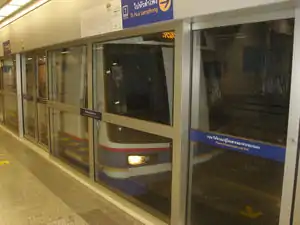 The train arriving at Si Lom station | ||||||||||||||||||||||||||||||||||||||||||||||||||||||||||||||||||||||||||||||||||||||||||||||||||||||||||||||||||||||||||||||||||||||||||||||||||||||||||||||||||||||||||||||||||||||||||||||||||||||||||||||||||||||||||||||||||||||||||||||||||||||||||||||||||||||||||||||||||||||||||||||||||||||||||||||||||||||||||||||||||||||||||||||||||||||||||||||||||||||||||||||||||||||||||||||||||||||||||||||||||||||||||||||
| Overview | ||||||||||||||||||||||||||||||||||||||||||||||||||||||||||||||||||||||||||||||||||||||||||||||||||||||||||||||||||||||||||||||||||||||||||||||||||||||||||||||||||||||||||||||||||||||||||||||||||||||||||||||||||||||||||||||||||||||||||||||||||||||||||||||||||||||||||||||||||||||||||||||||||||||||||||||||||||||||||||||||||||||||||||||||||||||||||||||||||||||||||||||||||||||||||||||||||||||||||||||||||||||||||||||
| Other name(s) | MRT Chalong Ratchadham Line | |||||||||||||||||||||||||||||||||||||||||||||||||||||||||||||||||||||||||||||||||||||||||||||||||||||||||||||||||||||||||||||||||||||||||||||||||||||||||||||||||||||||||||||||||||||||||||||||||||||||||||||||||||||||||||||||||||||||||||||||||||||||||||||||||||||||||||||||||||||||||||||||||||||||||||||||||||||||||||||||||||||||||||||||||||||||||||||||||||||||||||||||||||||||||||||||||||||||||||||||||||||||||||||
| Owner | Mass Rapid Transit Authority | |||||||||||||||||||||||||||||||||||||||||||||||||||||||||||||||||||||||||||||||||||||||||||||||||||||||||||||||||||||||||||||||||||||||||||||||||||||||||||||||||||||||||||||||||||||||||||||||||||||||||||||||||||||||||||||||||||||||||||||||||||||||||||||||||||||||||||||||||||||||||||||||||||||||||||||||||||||||||||||||||||||||||||||||||||||||||||||||||||||||||||||||||||||||||||||||||||||||||||||||||||||||||||||
| Locale | Bangkok | |||||||||||||||||||||||||||||||||||||||||||||||||||||||||||||||||||||||||||||||||||||||||||||||||||||||||||||||||||||||||||||||||||||||||||||||||||||||||||||||||||||||||||||||||||||||||||||||||||||||||||||||||||||||||||||||||||||||||||||||||||||||||||||||||||||||||||||||||||||||||||||||||||||||||||||||||||||||||||||||||||||||||||||||||||||||||||||||||||||||||||||||||||||||||||||||||||||||||||||||||||||||||||||
| Termini | ||||||||||||||||||||||||||||||||||||||||||||||||||||||||||||||||||||||||||||||||||||||||||||||||||||||||||||||||||||||||||||||||||||||||||||||||||||||||||||||||||||||||||||||||||||||||||||||||||||||||||||||||||||||||||||||||||||||||||||||||||||||||||||||||||||||||||||||||||||||||||||||||||||||||||||||||||||||||||||||||||||||||||||||||||||||||||||||||||||||||||||||||||||||||||||||||||||||||||||||||||||||||||||||
| Stations | 38 | |||||||||||||||||||||||||||||||||||||||||||||||||||||||||||||||||||||||||||||||||||||||||||||||||||||||||||||||||||||||||||||||||||||||||||||||||||||||||||||||||||||||||||||||||||||||||||||||||||||||||||||||||||||||||||||||||||||||||||||||||||||||||||||||||||||||||||||||||||||||||||||||||||||||||||||||||||||||||||||||||||||||||||||||||||||||||||||||||||||||||||||||||||||||||||||||||||||||||||||||||||||||||||||
| Color on map | Blue | |||||||||||||||||||||||||||||||||||||||||||||||||||||||||||||||||||||||||||||||||||||||||||||||||||||||||||||||||||||||||||||||||||||||||||||||||||||||||||||||||||||||||||||||||||||||||||||||||||||||||||||||||||||||||||||||||||||||||||||||||||||||||||||||||||||||||||||||||||||||||||||||||||||||||||||||||||||||||||||||||||||||||||||||||||||||||||||||||||||||||||||||||||||||||||||||||||||||||||||||||||||||||||||
| Service | ||||||||||||||||||||||||||||||||||||||||||||||||||||||||||||||||||||||||||||||||||||||||||||||||||||||||||||||||||||||||||||||||||||||||||||||||||||||||||||||||||||||||||||||||||||||||||||||||||||||||||||||||||||||||||||||||||||||||||||||||||||||||||||||||||||||||||||||||||||||||||||||||||||||||||||||||||||||||||||||||||||||||||||||||||||||||||||||||||||||||||||||||||||||||||||||||||||||||||||||||||||||||||||||
| Type | Rapid transit | |||||||||||||||||||||||||||||||||||||||||||||||||||||||||||||||||||||||||||||||||||||||||||||||||||||||||||||||||||||||||||||||||||||||||||||||||||||||||||||||||||||||||||||||||||||||||||||||||||||||||||||||||||||||||||||||||||||||||||||||||||||||||||||||||||||||||||||||||||||||||||||||||||||||||||||||||||||||||||||||||||||||||||||||||||||||||||||||||||||||||||||||||||||||||||||||||||||||||||||||||||||||||||||
| System | MRT | |||||||||||||||||||||||||||||||||||||||||||||||||||||||||||||||||||||||||||||||||||||||||||||||||||||||||||||||||||||||||||||||||||||||||||||||||||||||||||||||||||||||||||||||||||||||||||||||||||||||||||||||||||||||||||||||||||||||||||||||||||||||||||||||||||||||||||||||||||||||||||||||||||||||||||||||||||||||||||||||||||||||||||||||||||||||||||||||||||||||||||||||||||||||||||||||||||||||||||||||||||||||||||||
| Services | Tha Phra - Lak Song Special Services: Tha Phra - Bang Wa Phetkasem 48 - Bang Pho Lak Song - Tao Poon via Phra Ram 9 Lak Song - Tao Poon via Tha Phra Platform 3&4 | |||||||||||||||||||||||||||||||||||||||||||||||||||||||||||||||||||||||||||||||||||||||||||||||||||||||||||||||||||||||||||||||||||||||||||||||||||||||||||||||||||||||||||||||||||||||||||||||||||||||||||||||||||||||||||||||||||||||||||||||||||||||||||||||||||||||||||||||||||||||||||||||||||||||||||||||||||||||||||||||||||||||||||||||||||||||||||||||||||||||||||||||||||||||||||||||||||||||||||||||||||||||||||||
| Operator(s) | Bangkok Expressway and Metro | |||||||||||||||||||||||||||||||||||||||||||||||||||||||||||||||||||||||||||||||||||||||||||||||||||||||||||||||||||||||||||||||||||||||||||||||||||||||||||||||||||||||||||||||||||||||||||||||||||||||||||||||||||||||||||||||||||||||||||||||||||||||||||||||||||||||||||||||||||||||||||||||||||||||||||||||||||||||||||||||||||||||||||||||||||||||||||||||||||||||||||||||||||||||||||||||||||||||||||||||||||||||||||||
| Depot(s) | Phra Ram 9 Phetkasem | |||||||||||||||||||||||||||||||||||||||||||||||||||||||||||||||||||||||||||||||||||||||||||||||||||||||||||||||||||||||||||||||||||||||||||||||||||||||||||||||||||||||||||||||||||||||||||||||||||||||||||||||||||||||||||||||||||||||||||||||||||||||||||||||||||||||||||||||||||||||||||||||||||||||||||||||||||||||||||||||||||||||||||||||||||||||||||||||||||||||||||||||||||||||||||||||||||||||||||||||||||||||||||||
| Rolling stock | Siemens Modular Metro EMU-IBL Siemens Modular Metro EMU-BLE | |||||||||||||||||||||||||||||||||||||||||||||||||||||||||||||||||||||||||||||||||||||||||||||||||||||||||||||||||||||||||||||||||||||||||||||||||||||||||||||||||||||||||||||||||||||||||||||||||||||||||||||||||||||||||||||||||||||||||||||||||||||||||||||||||||||||||||||||||||||||||||||||||||||||||||||||||||||||||||||||||||||||||||||||||||||||||||||||||||||||||||||||||||||||||||||||||||||||||||||||||||||||||||||
| History | ||||||||||||||||||||||||||||||||||||||||||||||||||||||||||||||||||||||||||||||||||||||||||||||||||||||||||||||||||||||||||||||||||||||||||||||||||||||||||||||||||||||||||||||||||||||||||||||||||||||||||||||||||||||||||||||||||||||||||||||||||||||||||||||||||||||||||||||||||||||||||||||||||||||||||||||||||||||||||||||||||||||||||||||||||||||||||||||||||||||||||||||||||||||||||||||||||||||||||||||||||||||||||||||
| Commenced | 2 December 1996 | |||||||||||||||||||||||||||||||||||||||||||||||||||||||||||||||||||||||||||||||||||||||||||||||||||||||||||||||||||||||||||||||||||||||||||||||||||||||||||||||||||||||||||||||||||||||||||||||||||||||||||||||||||||||||||||||||||||||||||||||||||||||||||||||||||||||||||||||||||||||||||||||||||||||||||||||||||||||||||||||||||||||||||||||||||||||||||||||||||||||||||||||||||||||||||||||||||||||||||||||||||||||||||||
| Opened | 3 July 2004 | |||||||||||||||||||||||||||||||||||||||||||||||||||||||||||||||||||||||||||||||||||||||||||||||||||||||||||||||||||||||||||||||||||||||||||||||||||||||||||||||||||||||||||||||||||||||||||||||||||||||||||||||||||||||||||||||||||||||||||||||||||||||||||||||||||||||||||||||||||||||||||||||||||||||||||||||||||||||||||||||||||||||||||||||||||||||||||||||||||||||||||||||||||||||||||||||||||||||||||||||||||||||||||||
| Last extension | 23 December 2019 | |||||||||||||||||||||||||||||||||||||||||||||||||||||||||||||||||||||||||||||||||||||||||||||||||||||||||||||||||||||||||||||||||||||||||||||||||||||||||||||||||||||||||||||||||||||||||||||||||||||||||||||||||||||||||||||||||||||||||||||||||||||||||||||||||||||||||||||||||||||||||||||||||||||||||||||||||||||||||||||||||||||||||||||||||||||||||||||||||||||||||||||||||||||||||||||||||||||||||||||||||||||||||||||
| Technical | ||||||||||||||||||||||||||||||||||||||||||||||||||||||||||||||||||||||||||||||||||||||||||||||||||||||||||||||||||||||||||||||||||||||||||||||||||||||||||||||||||||||||||||||||||||||||||||||||||||||||||||||||||||||||||||||||||||||||||||||||||||||||||||||||||||||||||||||||||||||||||||||||||||||||||||||||||||||||||||||||||||||||||||||||||||||||||||||||||||||||||||||||||||||||||||||||||||||||||||||||||||||||||||||
| Line length | 48 km (30 mi) Elevated:20.78 km (12.91 mi) Underground:27.22 km (16.91 mi) | |||||||||||||||||||||||||||||||||||||||||||||||||||||||||||||||||||||||||||||||||||||||||||||||||||||||||||||||||||||||||||||||||||||||||||||||||||||||||||||||||||||||||||||||||||||||||||||||||||||||||||||||||||||||||||||||||||||||||||||||||||||||||||||||||||||||||||||||||||||||||||||||||||||||||||||||||||||||||||||||||||||||||||||||||||||||||||||||||||||||||||||||||||||||||||||||||||||||||||||||||||||||||||||
| Track gauge | 1,435 mm (4 ft 8+1⁄2 in) standard gauge | |||||||||||||||||||||||||||||||||||||||||||||||||||||||||||||||||||||||||||||||||||||||||||||||||||||||||||||||||||||||||||||||||||||||||||||||||||||||||||||||||||||||||||||||||||||||||||||||||||||||||||||||||||||||||||||||||||||||||||||||||||||||||||||||||||||||||||||||||||||||||||||||||||||||||||||||||||||||||||||||||||||||||||||||||||||||||||||||||||||||||||||||||||||||||||||||||||||||||||||||||||||||||||||
| Electrification | 750 V DC third rail | |||||||||||||||||||||||||||||||||||||||||||||||||||||||||||||||||||||||||||||||||||||||||||||||||||||||||||||||||||||||||||||||||||||||||||||||||||||||||||||||||||||||||||||||||||||||||||||||||||||||||||||||||||||||||||||||||||||||||||||||||||||||||||||||||||||||||||||||||||||||||||||||||||||||||||||||||||||||||||||||||||||||||||||||||||||||||||||||||||||||||||||||||||||||||||||||||||||||||||||||||||||||||||||
| Operating speed | 80 km/h (50 mph) | |||||||||||||||||||||||||||||||||||||||||||||||||||||||||||||||||||||||||||||||||||||||||||||||||||||||||||||||||||||||||||||||||||||||||||||||||||||||||||||||||||||||||||||||||||||||||||||||||||||||||||||||||||||||||||||||||||||||||||||||||||||||||||||||||||||||||||||||||||||||||||||||||||||||||||||||||||||||||||||||||||||||||||||||||||||||||||||||||||||||||||||||||||||||||||||||||||||||||||||||||||||||||||||
| Signalling | Siemens Trainguard LZB700M fixed block ATC under ATO GoA 2 (STO) | |||||||||||||||||||||||||||||||||||||||||||||||||||||||||||||||||||||||||||||||||||||||||||||||||||||||||||||||||||||||||||||||||||||||||||||||||||||||||||||||||||||||||||||||||||||||||||||||||||||||||||||||||||||||||||||||||||||||||||||||||||||||||||||||||||||||||||||||||||||||||||||||||||||||||||||||||||||||||||||||||||||||||||||||||||||||||||||||||||||||||||||||||||||||||||||||||||||||||||||||||||||||||||||
| ||||||||||||||||||||||||||||||||||||||||||||||||||||||||||||||||||||||||||||||||||||||||||||||||||||||||||||||||||||||||||||||||||||||||||||||||||||||||||||||||||||||||||||||||||||||||||||||||||||||||||||||||||||||||||||||||||||||||||||||||||||||||||||||||||||||||||||||||||||||||||||||||||||||||||||||||||||||||||||||||||||||||||||||||||||||||||||||||||||||||||||||||||||||||||||||||||||||||||||||||||||||||||||||
The MRT Blue Line (Thai: รถไฟฟ้า สายสีน้ำเงิน) or MRT Chaloem Ratchamongkon Line (Thai: รถไฟฟ้ามหานคร สายเฉลิมรัชมงคล) is Bangkok's third rapid transit line, following the Sukhumvit line and Silom line of the BTS Skytrain. It is the first of the MRT system and is operated by Bangkok Expressway and Metro (BEM). The original 20 km (12.43 mi) MRT Blue Line from Hua Lamphong to Bang Sue opened on 3 July 2004. A 1.2 km (0.75 mi) extension to Tao Poon opened on 11 August 2017. The 15.9 km (9.88 mi) western extension to Lak Song opened for full service on 29 September 2019 and the 11 km (6.84 mi) extension from Tao Poon to Tha Phra to form the quasi loop, opened for full service on 30 March 2020.
The line has a total length of 48 km (29.83 mi), being a quasi circle route of the Bangkok rapid transit network. The MRT Blue line connects major business, residential and cultural areas of Bangkok. In late 2019, the average daily ridership was 400,000.[1] In mid 2021, during a COVID-19 3rd wave in Bangkok ridership plummeted to between 76,000 - 116,000 per weekday.[2]
Route alignment
The MRT Blue Line starts at the upper platform of Tha Phra station. It runs on an elevated viaduct northward along Charan Sanit Wong Road to Bang O station. Then turning eastwards crossing the Chao Phraya River, entering Bang Pho station and Tao Poon station in Bang Sue District. The line then descends to an underground section. It follows the Kamphaeng Phet, Phahon Yothin and Lat Phrao Roads, then turns south following Ratchadaphisek Road to Queen Sirikit National Convention Centre station. It then turns west following Rama IV Road. It passes Hua Lamphong station in Pathum Wan District, through Chinatown, then under the Chao Phraya River before ascending onto an elevated viaduct to the lower platform of Tha Phra station. The line continues west along Phet Kasem Road to Lak Song station in Bang Khae, situated near Kanchanaphisek Road or Western Outer Ring road. It forms a quasi circle loop around Bangkok.
History
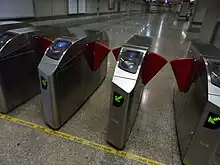
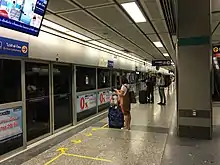
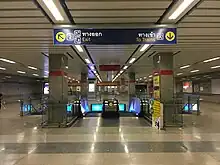
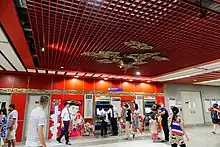
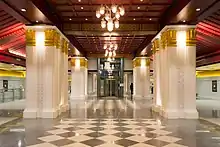
Officially named Chaloem Ratchamongkhon (Thai สายเฉลิมรัชมงคล) – "Celebration of Royal Auspice" – or informally but commonly called as the "MRT Blue Line", this was the first metro line under the newly formed government agency, the Mass Rapid Transit Authority of Thailand (MRTA). Most civil infrastructure was provided by this government agency and handed over to a private sector on a 25-year concessionaire agreement. The winning bidder was Bangkok Expressway and Metro (BEM). Under this agreement, BEM provides maintenance and engineering equipment, including electrical trains, signalling systems, SCADA, communication, platform screen doors and fully operate the system from Hua Lamphong to Bang Sue.[3][4] BEM has subcontracted maintenance of the system for 10 years to Siemens and seven-year maintenance contracts to two local maintenance services.[5]
Construction of the line from Hua Lamphong to Bang Sue began on 19 November 1996. The project suffered multiple delays not only because of the 1997 economic crisis, but also due to challenging civil engineering works of constructing massive underground structures deep in the water-logged soil upon which the city is built. The MRT Blue Line opened for a limited public trial period of several weeks starting on 13 April 2004. On 3 July 2004, the line was officially opened at 19:19 local time by HM King Bhumibol and Queen Sirikit who were accompanied by other members of the royal family. Within 30 minutes of its opening, sightseers filled the system to its maximum capacity, but after the initial rush ridership settled down to around 180,000 riders daily — considerably lower than projections of over 400,000, despite fares being slashed in half from 12 to 38 baht to 10-15 baht per trip.[6]
Extension to Tao Poon
As part of the rapid transit master plan the original MRT Blue Line section was planned to be extended from Hua Lamphong to Lak Song, and from Bang Sue to Tha Phra, forming a circle open-loop route. The contract for the first part of extension to Tao Poon was signed on 26 August 2009[7] as part of MRT Purple Line contract as it provided interchange to the MRT Purple Line. The 1.2 km (0.75 mi) Bang Sue to Tao Poon extension opened on 11 August 2017.[8] This added the first elevated station, Tao Poon, to the Blue line.[9][10]
Extensions to Lak Song and Tha Phra
The major extension of the MRT Blue Line was the 27 km (16.8 mi) extension west to Lak Song and from Tao Poon to Tha Phra with 19 stations consisting of four underground and 15 elevated stations. Contracts for civil work were divided into five contracts. Successful bids were announced in late 2010.[11][12][13] On 17 February 2011, the five contracts were signed.[14][15]
| Contract | Notes | Length |
|---|---|---|
| 1 | Hua Lamphong to Sanam Chai (2 stations underground, Bt11.65 billion, contractor ITD) | 2.8 km (1.7 mi) |
| 2 | Sanam Chai to Tha Phra (2 stations underground, Bt10.82B, contractor CK) | 2.6 km (1.6 mi) |
| 3 | Tao Poon to Tha Phra (8 stations elevated, Bt11.40B, contractor SH-Unique Joint venture) | 11 km (6.8 mi) |
| 4 | Tha Phra to Lak Song (7 stations elevated, plus a park-and-ride venue and maintenance yard, Bt13.43B, contractor STEC) | 10.5 km (6.5 mi) |
| 5 | Rolling stock and systems, Bt5.17 billion, contractor CK. |
Construction commenced in mid-2011 for a scheduled 2016 opening but this was subsequently delayed to 2019–2020. In August, 2017, BEM awarded the automatic fare collection ticket for the extension to Thales which to install its TransCity system.[16] The contract also includes ongoing training and future support. In September 2017, BEM announced that Siemens and ST Electronics Thailand were awarded the contract (Contract 5) to supply, install and maintain the E&S systems systems, install station platform screen doors and fit out the depot. Siemens also won the contract to supply 35 sets of rolling stock.[17]
In 2017, the cabinet approved the amendment of the Blue line concession[18] with BEM, and the new agreement was signed on 31 March 2017.[19] Under the new agreement, BEM will operate the new extensions from Hua Lampong to Lak Song and Bang Sue to Tha Phra. The concession period was extended from 2029 to 2050.
 Wat Mangkon station under construction. The station opened on 29 July 2019.
Wat Mangkon station under construction. The station opened on 29 July 2019.%252C_June_2016.jpg.webp) Bang Wa station under construction. The station opened on 29 July 2019.
Bang Wa station under construction. The station opened on 29 July 2019.
The extension was opened in stages. The Hua Lamphong - Lak Song extension was opened for trial service on 29 July with full commercial services commencing 29 September 2019.
| Hua Lamphong - Lak Song timeline of opening | |
|---|---|
| Date | Notes |
| 29 July 2019 | Free trial service from Hua Lumphong to Tha Phra commenced. Service on extension only available from 10.00 to 16.00. Passengers required to change train at Hua Lumphong for a service on extended route.[20] |
| 24 August 2019 | Service extended to Bang Wa.[21] |
| 21 September 2019 | Service was extended to Lak Song. Service hours were extended to the line's normal service hours of 06.00-24.00. |
| 29 September 2019 | Full commercial service was commenced. |
The Tao Poon - Tha Phra extension opened for limited trial services from 29 November 2019 with full commercial services commencing on 30 March 2020.
| Tao Poon - Tha Phra timeline of opening | |
|---|---|
| Date | Notes |
| 4 December 2019 | Free trial service from Tao Poon to Sirindhorn commenced. Service on extension only available from 10.00 to 16.00. Passengers required to change train at Tao Poon for a service on extended route.[22] |
| 23 December 2019 | Service was extended to Tha Phra.[23] |
| 1 March 2020 | Through service from Tha Phra to Lak Song via Bang Sue[24] |
| 30 March 2020 | Full commercial service commenced.[25] |
Rolling stock
The MRT Blue line is served by 54 three-car trains of which, 19 are first generation Siemens Modular Metro sets and 35 sets are second generation. The trains are powered by 750 V DC via third rail system, are air-conditioned and capable of traveling at up to 80 km/h (50 mph).[26]
First generation
19 three-car Siemens Modular Metro were ordered for the initial part of the line. The trains entered service on 3 July 2004.[27] In 2017, BEM starts removing some seats from the train to increase interior space to cope with rising number of passengers. In 2019, the BEM stated that it is interested in refurbishing the first generation trains. Including the CCTV cameras, and new dynamic route map replacing the traditional ones.[28]
 First Generation train of MRT Blue Line (Siemens Modular Metro) or EMU-IBL.
First Generation train of MRT Blue Line (Siemens Modular Metro) or EMU-IBL.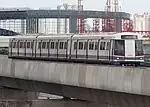 First Generation train near Tao Poon MRT station.
First Generation train near Tao Poon MRT station. Inside a Blue Line train, Siemens Modular Metro.
Inside a Blue Line train, Siemens Modular Metro. Interior of first generation trains. Noted only 1 row of handrails and hanging strap are present and with traditional route map above doors.
Interior of first generation trains. Noted only 1 row of handrails and hanging strap are present and with traditional route map above doors.
Second generation
In 2017, BEM ordered 35 three-car Siemens Modular Metros[29] as part of the line extension program.[30][31] Under the contract, Siemens were to supply 35 trains and provide maintenance for ten years with a price tag of 20 billion baht. The fleet was built at the Siemens plant in Vienna and tested in Germany. The first train arrived in 2019 with all trains delivered by early 2020.[32]
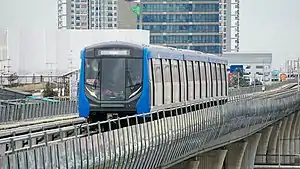 The second generation train (EMU-BLE) of MRT Blue Line
The second generation train (EMU-BLE) of MRT Blue Line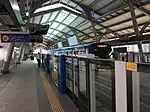 Second Generation train at platform level of Bang Wa MRT station
Second Generation train at platform level of Bang Wa MRT station Interior of second generation trains. With 3 rows of handrails and hanging strap. Along with dynamic route map.
Interior of second generation trains. With 3 rows of handrails and hanging strap. Along with dynamic route map. Dynamic route map on new trains
Dynamic route map on new trains
Stations
| Code | Station Name | Opened | Platform Type | Position | Park
& Ride |
Transfer | Location | |
|---|---|---|---|---|---|---|---|---|
| English | Thai | |||||||
| Tha Phra (Upper Platform) | ท่าพระ | 23 December 2019 | Island | Elevated | - | MRT (South section) | Bangkok Yai | |
| Charan 13 | จรัญฯ 13 | Side | - | |||||
| Fai Chai | ไฟฉาย | Side | - | Bangkok Noi | ||||
| Bang Khun Non | บางขุนนนท์ | Side | - | MRT (future)
SRT (future) Connecting station with Charansanitwong Halt for | ||||
| Bang Yi Khan | บางยี่ขัน | Side | - | Bang Phlat | ||||
| Sirindhorn | สิรินธร | 4 December 2019 | Side | - | ||||
| Bang Phlat | บางพลัด | Side | - | |||||
| Bang O | บางอ้อ | Side | - | |||||
| Bang Pho | บางโพ | Side | - | Mine Smart Ferry CHAOPHRAYA EXPRESS | Bang Sue | |||
| Tao Poon | เตาปูน | 11 August 2017 | Side | - | MRT | |||
| Bang Sue | บางซื่อ | 3 July 2004 | Side | Underground | - | Connecting station with Krung Thep Aphiwat Central Terminal for
• SRT Northern Line • SRT Northeastern Line • SRT Southern Line • HSR Northern Line (future) • HSR Northeastern Line (under construction) • HSR Eastern Line (future) • HSR Southern Line (future) |
Chatuchak | |
| Kamphaeng Phet | กำแพงเพชร | Island | - | |||||
| Chatuchak Park | สวนจตุจักร | Island | - | Connecting station with Mo Chit for BTS | ||||
| Phahon Yothin | พหลโยธิน | Island | - | Connecting station with Ha Yaek Lat Phrao for BTS | ||||
| Lat Phrao | ลาดพร้าว | Island | √ | Connecting station with MRT | ||||
| Ratchadaphisek | รัชดาภิเษก | Island | √ | Din Daeng/Huai Khwang | ||||
| Sutthisan | สุทธิสาร | Island | ||||||
| Huai Khwang | ห้วยขวาง | Island | √ | |||||
| Thailand Cultural Centre | ศูนย์วัฒนธรรมแห่งประเทศไทย | Island | √ | MRT (under construction) | ||||
| Phra Ram 9 | พระราม 9 | Island | √ | |||||
| Phetchaburi | เพชรบุรี | Island | √ | MRL (future)
Connecting station with Makkasan for
• Asok for • SRT Eastern Line |
Ratchathewi | |||
| Sukhumvit | สุขุมวิท | Island | √ | Connecting station with Asok for BTS | Watthana | |||
| Queen Sirikit National Convention Centre | ศูนย์การประชุมแห่งชาติสิริกิติ์ | Island | √ | Khlong Toei | ||||
| Khlong Toei | คลองเตย | Side | - | |||||
| Lumphini | ลุมพินี | Stacked | - | Sathon | ||||
| Si Lom | สีลม | Stacked | - | Connecting station with Sala Daeng for BTS | Bang Rak | |||
| Sam Yan | สามย่าน | Stacked | √ | Pathum Wan | ||||
| Hua Lamphong | หัวลำโพง | Island | - | Connecting station with Bangkok for
• SRT (future) • SRT Northern Line • SRT Northeastern Line • SRT Eastern Line • SRT Southern Line | ||||
| Wat Mangkon | วัดมังกร | 29 July 2019 | Stacked | - | Samphanthawong | |||
| Sam Yot | สามยอด | Stacked | - | MRT (under construction) | Phra Nakhon | |||
| Sanam Chai | สนามไชย | Island | - | Mine Smart Ferry CHAOPHRAYA EXPRESS | ||||
| Itsaraphap | อิสรภาพ | Island | - | Bangkok Yai | ||||
| Tha Phra (Lower Platform) | ท่าพระ | Side | Elevated | - | MRT (North section) | |||
| Bang Phai | บางไผ่ | 24 August 2019 | Side | - | Phasi Charoen | |||
| Bang Wa | บางหว้า | Side | - | Connecting station with BTS and Bang Wa pier for Khlong Phasi Charoen Boat Service | ||||
| Phetkasem 48 | เพชรเกษม 48 | 21 September 2019 | Side | - | ||||
| Phasi Charoen | ภาษีเจริญ | Side | - | |||||
| Bang Khae | บางแค | Side | - | Bang Khae | ||||
| Lak Song | หลักสอง | Side | √ | |||||
Operation
The MRT Blue line runs from Tha Phra to Lak Song via Bang Sue, Phra Ram 9 and Hua Lamphong, serving 38 stations. The line operates everyday from 6am to midnight with headway of 4 minutes during rush hour and a maximum headway of 8 minutes after 10 pm.[33]
All stations on the line are equipped with platform screen doors. Stations are built to accommodate six-car trains, but only three-car trains were used. Uniformed security personnel and security cameras are present at every platform. Passenger announcements on this line are made by journalist and news broadcaster Sarocha Pornudomsak. The line has 2 depots, one in Huai Khwang District,[34] which is located between Phra Ram 9 and Thailand Cultural Centre station. The 2nd depot is located in Chom Thong District, near Phetkasem 48 station.[35]
Fares increased by 1 baht from 1 January 2021. For example, a one station journey increases to Bt17 from Bt16, four stations to Bt24 from Bt23, seven stations to Bt31 from Bt30 and 10 stations to Bt38 from Bt37.[36] The maximum fare is 42 baht.
Ridership
At opening in 2004, initial ridership was 180,000 per day — considerably lower than the projections of over 400,000. By 2016, the average daily ridership was 273,637.[37] By September 2017, BEM stated that average daily ridership had increased to 360,000 after the opening of the extension to Tao Poon.[38]
After the opening of the extension to Lak Song on 29 September 2019, average daily ridership increased to 400,000.[1] The MRT Blue line was expected to grow to a daily ridership of 800,000 once the Lak Song and Tha Phra extensions opened. However, the impact of the COVID-19 pandemic by late 2020 had resulted in a dramatic reduction of ridership down to an average of 360,000 per weekday reverting to September 2017 levels.[39] By August 2021, during a COVID-19 3rd wave in Bangkok ridership plummeted to only 76,000 per weekday.[40]
Accident record
On 17 January 2005, just after 09:15, an empty train returning to the depot collided with a peak-hour train filled with passengers at the Thailand Cultural Centre station. Around 100-262 people, depending on the news source, were injured.[41][42][43] Most of whom sustained only minor injuries, and the entire Metro network was shut down for two weeks. On 31 January 2005, then prime minister Thaksin Shinawatra rode the metro to increase public confidence in the system.
After initial investigations, it was found that the empty train had run into problems shortly before the accident, grinding to a halt on a curve leading to the depot. The driver applied its brake and was waiting to be towed to the depot close to Thailand Cultural Centre station. A rescue train was attempting to connect to the stalled train when the driver was told to release the brake while coupling had not yet been successful. It was then that the empty train began to roll backwards at a speed of ten meters per second, before smashing into the other train, which was carrying passengers. Therefore, it was believed that the incident was caused by negligence due to insufficient training of operation staff.[44] This accident also resulted in two damaged trains with heavily damaged areas limited to the two leading cars. The colliding speed was suspected to be about 60 km/h due to the appearance of damaged areas. However, one train, which was rebuilt from the repair of the minor-damaged cars, was already fitted for operation at the end of 2006 and the remaining one was still under heavy repair until mid of 2007; it was released into service in October 2007. The cost resulting from the accident might be a much higher figure than BEM quoted, and it was expected to be at least 400 million baht, which was totally insured by a local insurance company.[41]
The line resumed full operations on 1 February 2005. Passenger numbers soon rose back to pre-crash levels, partly due to a temporary promotional fare scheme which allowed passengers to travel any distance on the MRT for only ten baht.
Line map
Network map
Future extensions
Since 2011, there were requests from residents to extend the line farther from Lak Song west to the Phutthamonthon area. The MRTA indicated a willingness to undertake this extension. In July 2014, the MRTA submitted a request for 84 million baht to complete a route survey for a 7.8 km (4.8 mi), 4 station extension from Lak Song to Phutthamonthon Sai 4.[45] In late March 2017, the Transport Ministry stated that this 7.8 km extension would be submitted to Cabinet for approval in April 2017 with construction expected to commence in the 4th quarter of 2017.[46] However, the tender was subsequently delayed until late 2019 due to other projects. In late 2019, the project was put on hold due to government budget constraints.[47] In August 2021, the MRTA confirmed that the extension was not a priority especially given delays with the tenders for the MRT Orange and MRT Purple line extensions.[48]
| Code | Station Name | Connections | Location | |
|---|---|---|---|---|
| English | Thai | |||
| BL39 | Phutthamonthon Sai 2 | พุทธมณฑลสาย 2 | Bang Khae/Nong Khaem | |
| BL40 | Thawi Watthana | ทวีวัฒนา | ||
| BL41 | Phutthamonthon Sai 3 | พุทธมณฑลสาย 3 | ||
| BL42 | Phutthamonthon Sai 4 | พุทธมณฑลสาย 4 | ||
See also
- Mass Rapid Transit Master Plan in Bangkok Metropolitan Region
- MRT (Bangkok)
- MRT Brown Line
- MRT Grey Line
- MRT Light Blue Line
- MRT Orange Line
- MRT Pink Line
- MRT Purple Line
- MRT Yellow Line
- BTS Skytrain
- BTS Sukhumvit Line
- BTS Silom Line
- AERA1 City
- SRT Light Red Line
- SRT Dark Red Line
- Bangkok BRT
- BMA Gold Line
References
- 1 2 https://www.khaosod.co.th/economics/news_2933591. Khaosod, 30 September 2019
- ↑ "BEM website. Monthly ridership".
- ↑ "BEM Investor presentation" (PDF).
- ↑ "M.R.T. Chaloem Ratchamongkhon Line". MRTA Website. Retrieved 24 April 2020.
- ↑ "Mass Rapid Transit Authority of Thailand". mrta.co.th. Retrieved 14 April 2017.
- ↑ Bangkok's First Underground Metro Opens International Railway Journal July 2004 page 32
- ↑ "ลงนามสัญญาที่1 รถไฟสีม่วง ช.การช่างได้เฮ". thairath.co.th (in Thai). 26 August 2009. Retrieved 24 April 2020.
- ↑ "Purple Line to connect with MRT on Aug 11". Bangkok Post. Retrieved 24 April 2020.
- ↑ "Blue Line Tao Poon extension opening date (Thai)". 11 August 2017.
- ↑ "เปิดวิ่งเชื่อมต่อสถานีเตาปูน-บางซื่อ 12.00 วันนี้". bangkokbiznews.com/. 11 August 2017. Retrieved 27 April 2020.
- ↑ "ช.การช่างคว้าประมูลรถไฟฟ้าสีน้ำเงินหัวลำโพง-ท่าพระ". posttoday.com. July 2010. Retrieved 24 April 2020.
- ↑ "ยูนิค-ชิโนไทย ชนะประมูลสร้างรถไฟฟ้าสีน้ำเงิน 2 สัญญา". thairath.co.th (in Thai). 2 June 2010. Retrieved 24 April 2020.
- ↑ "ช.เข้าวินวางรางสีน้ำเงิน รฟม.ยัน 5 สัญญาเซ็นได้ ต.ค.นี้". thairath.co.th (in Thai). 25 August 2010. Retrieved 24 April 2020.
- ↑ "Published | การรถไฟฟ้าขนส่งมวลชนแห่งประเทศไทย". mrta.co.th. Retrieved 24 April 2020.
- ↑ Bangkok to complete Blue Line loop Railway Gazette International 19 March 2011
- ↑ "Thales wins Bangkok metro fare collection contract". International Railway Journal. 23 August 2017.
- ↑ "Siemens consortium wins Bangkok Blue Line extension contract". International Railway Journal. 19 September 2017.
- ↑ "ปิดดีลเดินรถสีน้ำเงิน ครม.ผ่านฉลุย เร่งเซ็นสัญญาจ้าง Bem ทยอยเปิดเดินรถปลายปี 62". mgronline.com. 28 March 2017. Retrieved 24 April 2020.
- ↑ "BEM significant event in 2017" (PDF).
- ↑ "รัฐมนตรีว่าการกระทรวงคมนาคม กดปุ่มเปิดการทดลองให้บริการโครงการรถไฟฟ้าสายสีน้ำเงิน ส่วนต่อขยาย ช่วงหัวลำโพง – บางแค". metro.bemplc.co.th (in Thai). Retrieved 24 April 2020.
- ↑ "24 สิงหาคมนี้ รฟม. และ BEM เปิดให้ประชาชนทดลองใช้บริการรถไฟฟ้า เพิ่มอีก 2 สถานี (สถานีวัดมังกร – สถานีบางหว้า)". metro.bemplc.co.th (in Thai). Retrieved 24 April 2020.
- ↑ "Free travel between new BTS, MRT train stations". Bangkok Post. Retrieved 22 June 2020.
- ↑ "วันที่ 23 ธันวาคม 2562 รฟม. และ BEM เปิดให้ประชาชนทดลองใช้บริการรถไฟฟ้าสายสีน้ำเงินส่วนต่อขยาย ช่วงเตาปูน - ท่าพระ". metro.bemplc.co.th (in Thai). Retrieved 24 April 2020.
- ↑ "1 มีนาคมนี้ รฟม. และ BEM ให้บริการรถไฟฟ้าสายสีน้ำเงินส่วนต่อขยายเดินทางต่อเนื่อง โดยไม่ต้องเปลี่ยนขบวนรถที่สถานีเตาปูน". metro.bemplc.co.th (in Thai). Retrieved 24 April 2020.
- ↑ "30 มีนาคมนี้ รฟม. และ BEM พร้อมเปิดให้บริการรถไฟฟ้าสายเฉลิมรัชมงคลช่วงเตาปูน – ท่าพระ (สายสีน้ำเงินส่วนต่อขยาย) อย่างเป็นทางการ". metro.bemplc.co.th (in Thai). Retrieved 24 April 2020.
- ↑ "BEM บริษัททางด่วนและรถไฟฟ้ากรุงเทพจำกัด (มหาชน)". metro.bemplc.co.th (in Thai). Retrieved 26 April 2020.
- ↑ "Bangkok Metro". Railway Technology. Retrieved 26 April 2020.
- ↑ "บุกโรงงานซีเมนส์...ผลิตรถไฟฟ้า MRT-BEM ดีไซน์เพิ่มระบบเซฟตี้รองรับผู้โดยสารทุกกลุ่ม". mgronline.com (in Thai). Retrieved 26 April 2020.
- ↑ "Blue Line in Bangkok to be extended with Siemens technology". Siemens Mobility Press Release. Munich. 19 September 2017.
- ↑ "BEM to buy 35 more Blue Line trains". bangkokpost.com. Retrieved 26 April 2020.
- ↑ "Siemens wins contract for Bangkok Blue line extension". Railway PRO. 19 September 2017. Retrieved 26 April 2020.
- ↑ "MRTA – BEM Announce that the First New Train for the MRT Blue Line Extension Has Arrived". ryt9.com (in Thai). Retrieved 26 April 2020.
- ↑ "แผนที่เส้นทาง". metro.bemplc.co.th (in Thai). Retrieved 28 April 2020.
- ↑ "MRT เตรียมซ้อมจัดการเหตุการณ์ 24 ก.ย. 10.30-15.30 น. ที่ศูนย์ซ่อมฯ พระราม 9". mgronline.com (in Thai). 23 September 2019. Retrieved 28 April 2020.
- ↑ "Brochure issued by MRTA, detailing Blue line extension program" (PDF). Archived from the original (PDF) on 13 December 2019. Retrieved 28 April 2020.
- ↑ "Blue Line in Bangkok to be extended with Siemens technology". The Nation. Bangkok. 20 November 2020.
- ↑ "Financial Summary of the Consolidated Financial Statements of Bangkok Expressway and Metro Public Company Limited and its Subsidiaries" (PDF). 2017.
- ↑ "BEM to buy 35 more Blue Line trains". Bangkok Post. Bangkok. 15 September 2017.
- ↑ เช็กคืบหน้ารถไฟฟ้าทุกสี ต้นปี 64 เปิดประมูล สีม่วง “เตาปูน-ราษฎร์บูรณะ. Prachachat, 1 December 2020
- ↑ "BEM website. Monthly ridership".
- 1 2 "3 นาทีคดีดัง : ชนสนั่น! วันโกลาหล รถไฟฟ้าใต้ดิน (คลิป)". thairath.co.th (in Thai). 14 April 2019. Retrieved 27 April 2020.
- ↑ "เจ็บเป็นร้อย!!! รถไฟฟ้าใต้ดินชนกัน คนขับสาหัส". mgronline.com. 17 January 2005. Retrieved 27 April 2020.
- ↑ "Article with photos of an event".
- ↑ "Thai subway shut for safety probe". BBC News. 17 January 2005. Retrieved 13 May 2010.
- ↑ ลุ้นคลังไฟเขียวงบรถไฟ-รฟม [Win No Green Light Railway Company - MRTA]. Than Online (in Thai). 15 July 2014.
- ↑ "Blue Line extension, freeway pends Cabinet approval". The Bangkok Post. Bangkok. 26 March 2017. Retrieved 28 March 2017.
- ↑ "ชะลอทำรถไฟฟ้า3สายหวั่นผู้โดยสารน้อย/ไม่คุ้มทุน". ryt9.com (in Thai). Retrieved 24 April 2020.
- ↑ "รฟม.ขึงไทม์ไลน์ ต.ค.ประมูล "สายสีส้ม-สีม่วงใต้" ยึด กม.จัดซื้อฯ ยันเกณฑ์เทคนิคและราคาเหมาะสม". Manager. 19 August 2021.
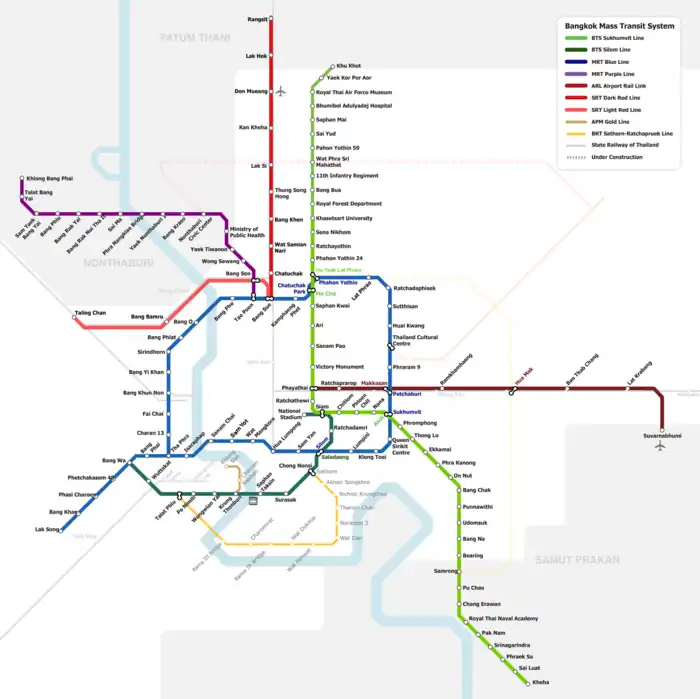
.svg.png.webp)